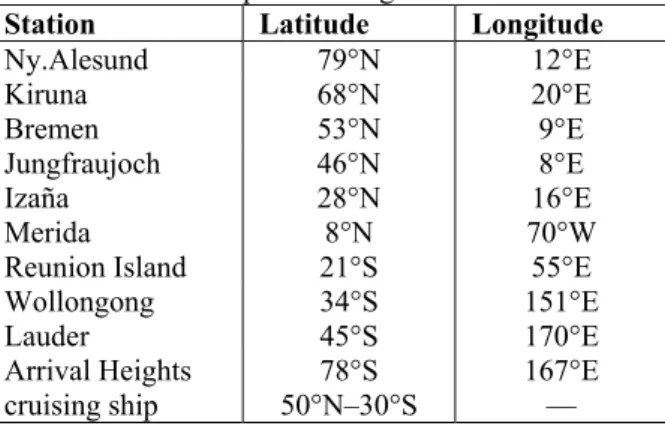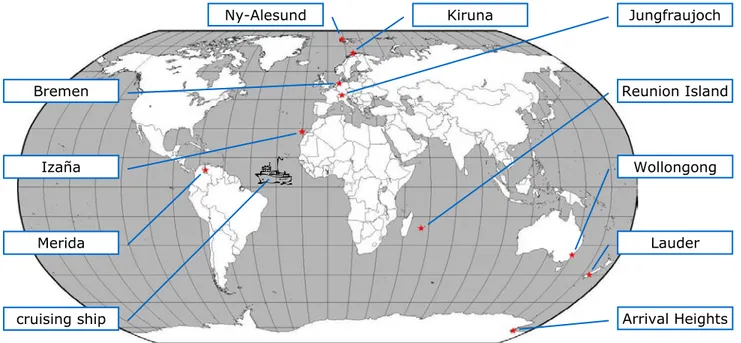VALIDATION OF IASI ATMOSPHERIC CHEMISTRY PRODUCTS FOR CO, O3, HNO3,
N2O AND CH4 WITH FTIR GROUND-BASED NETWORK DATA
M. De Mazière(1), M. Kruglanski(1) , B. Dils(1), C. Vigouroux(1), A.-C. Vandaele(1), T. Blumenstock(2), P. Demoulin(3), E. Mahieu(3), J. Notholt(4), S. Wood(5), N. Jones(6)
1)Belgian Institute for Space Aeronomy (BIRA-IASB), Brussels, Belgium, martine@oma.be (2)Institute of Meteorology and Climate Research, Karlsruhe, Germany, thomas.blumenstock@imk.fzk.de
(3)Institute of Astrophysics, University of Liège, Belgium, emmanuel.mahieu@ulg.ac.be
(4)Institute of Environmental Physics, University of Bremen, German, jnotholt@iup.physik.uni-bremen.de (5)National Institute of Water and Atmospheric Research, New Zealand, s.wood@niwa.co.nz (6)Atmospheric Chemistry Research Group, University of Wollongong, Australia, njones@uow.edu.au
RESUME
For every satellite experiment, it is extremely important to perform a thorough validation of the geophysical data products to guarantee a correct assessment of the capabilities and performances of the satellite experiment. IASI on METOP-1 will be the first Fourier transform infrared (FTIR) spectrometer of the METOP series to be launched. With METOP the emphasis is on the meteorological data products. However, this project will support the expectations of the atmospheric chemistry community who is very interested in the exploitation of the IASI spectra for deriving additional geophysical data products. Expected IASI data products are total columns and information as to the vertical distribution of the following gaseous species: CO, O3, HNO3, N2O and
CH4. These gases play key roles in tropospheric
chemistry and climate. This project will use independent correlative data at 11 stations worldwide to validate the before mentioned IASI products, while covering all major latitude bands. Recently developed inversion strategies for the ground-based FTIR data will be applied to provide correlative data of the highest possible quality for the present validation purposes.
1. SCIENTIFIC ISSUES
With IASI onboard, METOP has the capability of filling the gap in the availability of satellite data for tropospheric chemistry and climate researches that is expected in the post-Envisat era. But, to achieve this goal, the IASI performances for delivering appropriate geophysical data must be verified.
Also measured by MOPITT and TES, CO is an important O3 precursor in the troposphere. While O3 is
measured by many satellite instruments (Envisat, Aura, ...), IASI should reach a better sensitivity to the troposphere region. The variability of HNO3 in the
troposphere is known to be large, mainly from aircraft and balloon measurements. But it has not been
measured yet on a global scale, except for some IMG measurements. N2O and CH4 are important greenhouse
gases. N2O is also a major component of the nitrogen
budget.
2. ANALYSIS METHOD
Ground-based data will be collected from 11 mobile or fixed stations worldwide with NDSC-qualified FTIR spectrometers for remote sensing of the atmospheric composition. Fig. 1 and Table 1 identify the locations of the contributing stations. The stations cover all major latitude bands. Except for the site at Reunion Island and for the ship cruises, all the stations operate on a quasi continuous basis and have long time series of data, spanning at least a decade. The operation of an FTIR experiment at Merida is not guaranteed yet. At Reunion Island, the site is operated on a campaign basis. The ship cruises travel over the Atlantic Ocean from Bremerhaven to Cape Town. These cruises mostly happen every year, since more than 10 years now. Both stations of Jungfraujoch and Izaña are located at high altitudes (3580 and 2367 m, resp.) and provide observations above the boundary layer.
The project is split in three phases. During the first phase, an optimum common data retrieval strategy to Table 1. Spatial coordinates of the ground-based FTIR
stations depicted in Fig. 1.
Station Latitude Longitude
Ny.Alesund 79°N 12°E Kiruna 68°N 20°E Bremen 53°N 9°E Jungfraujoch 46°N 8°E Izaña 28°N 16°E Merida 8°N 70°W
Reunion Island 21°S 55°E
Wollongong 34°S 151°E
Lauder 45°S 170°E
Arrival Heights 78°S 167°E
cruising ship 50°N–30°S —
Proceedings of the 1st EPS/MetOp RAO Workshop, 15-17 May 2006, ESRIN, Frascati, Italy (ESA SP-618, August 2006)
invert the spectral FTIR data to vertical profiles of the target species will be established. This implies the choice of retrieval microwindows and ancillary parameters, the choice of spectroscopic data, etc. During the second phase comparisons between IASI Level 2 data and the early correlative ground-based data will be made using all network data. These comparisons will be supported by ancillary meteorological data and additional METOP data products from AVHRR (clouds and surface images) and GOME-2 (O3 products) for a better interpretation
of the results. The comparisons should provide insights in possible latitudinal, seasonal, and/or surface dependencies of the results. Finally in the last phase, the comparisons will be refined by including more data and reprocessing updated data.
The validation of IASI by ground-based FTIR is not straightforward due to the inherent different properties of both measurements. Several issues have to be addressed in order to perform a proper comparison. The first issue is related to the differences in altitude sensitivity between satellite-based and ground-based observations, which directly affects the evaluation of the total column and requires a specific normalisation of the total columns. This normalisation should take into account the averaging kernels associated to the total column inversions. A second issue concerns the availability of ground-based FTIR data because the observations can be made in clear-sky conditions only. To overcome the poor number of real coincidences and to ensure a statistically significant correlative data set, temporal interpolation techniques through the FTIR ground-based data will be considered. A third issue
involves the difference in observed air masses that might create apparent biases between FTIR and IASI measurements. It is particularly the case with mountainous ground-based stations for which the corresponding IASI pixel could include part of the surrounding valleys that often harbour significantly higher concentrations of pollutants.
3. CONSORTIUM EXPERTISE
The six partners have a long-lasting expertise in FTIR remote sensing: observations, algorithm developments, data analysis, and exploitation of the data for satellite validation. They have been working together since many years as members of the Infrared Working Group of NDACC (Network for the Detection of Atmospheric Composition Change, formerly NDSC, http://www.ndacc.org), and more recently in the European EC-funded project UFTIR (http://www.nilu.no/uftir).
In these collaborations, the capabilities of ground-based FTIR for the determination of tropospheric abundances have been demonstrated, and the homogenization of the tropospheric retrieval products across the network has been improved. For example for O3, it has been established that the FTIR profiles
are in excellent agreement with O3 sonde
measurements and that the total column values agree to better than 1% with Dobson/Brewer data [1, 2]. CO profile measurements have been shown to agree very well with in-situ measurements; they have also been characterized in comparison with MOPITT [3]. Comparisons between SCIAMACHY and FTIR ground-based data for CO, CH4, CO2 and N2O total
Kiruna Bremen Izaña Merida Reunion Island Wollongong Arrival Heights cruising ship Lauder Jungfraujoch Ny-Alesund
Figure 1. Distribution of stations contributing to the delivery of correlative ground-based FTIR data for comparisons with IASI products. The ship cruises travel over the Atlantic Ocean.
columns [4], and between MIPAS and FTIR ground-based data for N2O and HNO3 profiles [5] have proved
the robustness of the FTIR data retrievals from the network. FTIR ground-based data for O3, N2O and
CH4 data have also been compared successfully to
independent model results [6].
In addition to the comparisons with independent data, side-by-side intercomparisons between FTIR instruments have been carried out, demonstrating good mutual agreements between the measurement results (among others for N2O, CH4 and HNO3) in similar
operating conditions (e.g., [7], [8], and references therein).
Some members of the consortium have also a long-standing expertise in laboratory spectroscopy for atmospheric applications that can provide uncertainty estimates as to the spectroscopic data used on the one hand in the ground-based FTIR and on the other hand in the satellite (IASI) retrievals.
4. REFERENCES
1. Schneider M., Blumenstock T., Hase F., Höpfner M., Cuevas E., Redondas A., Sancho J.M., Ozone profiles and total column amounts at Izaña, Tenerife Island, from FTIR solar absorption spectra, and its validation by intercomparison to ECC-sonde and Brewer spectrometer measurements, J. Quant. Spectr. Rad. Transfer, 91, 245-274, 2005.
2. Barret B., De Mazière M., Demoulin P., Retrieval and characterisation of ozone profiles from solar infrared spectra at the Jungfraujoch, J. Geophys. Res, 10.1029/2001JD001298, 2002.
3. Barret B., De Mazière M. and Mahieu E., Ground-based FTIR measurements of CO from the Jungfraujoch: characterisation and comparison with in-situ surface and MOPITT data, ACP, 3, 2217-2223, 2003.
4. Dils B., De Mazière M., Müller J.F., Blumenstock T., Buchwitz M., de Beek R.,Demoulin P.,
Duchatelet P.,Fast H., Frankenberg C., Gloudemans A., Griffith D., Jones N., Kerzenmacher T., Kramer I., Mahieu E., Mellqvist J., Mittermeier R.L., Notholt J., Rinsland C.P., Schrijver H., Smale D., Strandberg A., Straume1 A.G., Stremme W., Strong K., Sussmann R., Taylor J., van den Broek M., Velazco V., Wagner T., Warneke T., Wiacek A. and Wood S., Comparisons between SCIAMACHY and ground-based FTIR data for total columns of CO, CH4, CO2 and N2O, Atmos. Chem. Phys.,
accepted, 2006.
5. Vigouroux C., De Mazière M., Wood S., Smale D., Mahieu E., Duchatelet P., Jones N. and Murcray F., Intercomparisons of MIPAS operational N2O and
HNO3 profiles with ground-based FTIR data,
submitted to Atmos. Chem. Phys., May 2006. 6. Schneider M., Blumenstock T., Chipperfield M.P.,
Hase F., Kouker W., Reddman T., Ruhnke R., Cuevas E. and Fischer H., Subtropical trace gas profiles determined by ground-based FTIR spectroscopy at Izaña (28°N, 16°W): Five-year record, error analysis, and comparison with 3-D CTMs, Atmos. Chem. Phys. Disc, 4, 5261-5301, 2004.
7. Goldman A., Paton-Walsh C., Bell W., Toon G.C., Blavier J.-F., Sen B., Coffey M.T., Hannigan J.W. and Mankin W.G., Network for the Detection of Stratospheric Change Fourier transform infrared intercomparison at Table Mountain Facility, November 1996, J. Geophys. Res., 104, 30481-30503, 1999.
8. Paton-Walsh C., Bell W., Gardiner T., Swann N., Woods P., Notholt J., Schütt H., Galle B., Arlander W. and Mellqvist J., An uncertainty budget for ground-based Fourier transform infrared column measurements of HCl, HF, N2O and HNO3 deduced
from results of side-by-side instrument intercomparisons, J. Geophys. Res., 102, 8867-8873, 1997.

